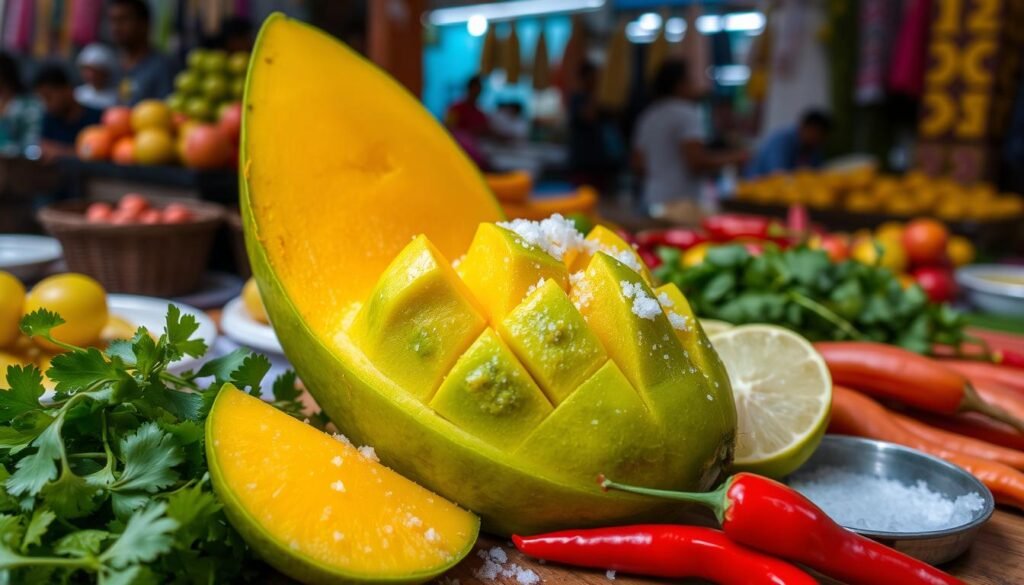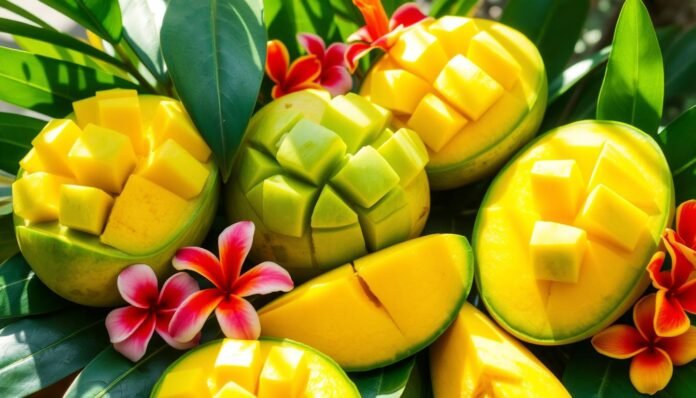Mango biche is a special tropical fruit from Colombia’s lush lands. It’s known for its unique, tangy taste. Unlike sweet mangoes, this long green fruit is refreshing and captures the tropics’ essence.
Exploring mango biche reveals its importance in Colombian food. You’ll learn how to enjoy it and grow tropical mango trees.
Let’s dive into the world of mango biche. It’s more than a tangy mango—it’s a thrilling food adventure!
Key Takeaways
- Mango biche offers a unique, tangy flavor profile cherished in Colombia.
- This tropical fruit is a popular street food, particularly in Bogota.
- Innovative forms like Mango Biche popsicles are gaining popularity.
- It serves as a refreshing contrast to sweeter mango varieties.
- Mango biche is considered a must-try when visiting Colombia.
- Cultivating mango biche can be rewarding with the right conditions.
- This tropical delight has become a staple in Colombian dessert cuisine.
Introduction to Mango Biche and Its Exotic Flavors
Mango biche is a favorite snack in Colombia, known for its tangy taste. It’s picked when green, giving a taste unlike sweeter mangoes. Its firm texture and tartness make it a hit, especially with lime juice and salt.
The Unique Taste Profile of Mango Biche
Mango biche’s flavor is a mix of sweet, sour, salty, and spicy. It’s a refreshing treat when seasoned with salt and lime juice. This mix of flavors is a key part of Colombian cuisine, offering a unique taste experience.
Comparing Mango Biche to Other Mango Varieties
Mango biche is different from sweeter mangoes like Haden or Tommy Atkins. It’s tart and crunchy, unlike the softer, sweeter varieties. As a snack or in recipes, mango biche shines. It’s perfect for those looking to try something new in the kitchen.
The Cultural Significance of Mango Biche in Colombian Cuisine
Mango biche is a key part of Colombian street food. Vendors in lively markets sell this tropical fruit as a snack and a culinary delight. It’s served on a stick, with lime juice, salt, and sometimes hot sauce.
Street Food Staple: How Mango Biche is Enjoyed
Colombians love mango biche for its unique taste and texture. They enjoy it in plazas and streets. Here’s how they eat it:
- They get a skewer of fresh fruit from a vendor
- Then, they drizzle lime juice over it
- Next, they sprinkle salt for a savory touch
- And sometimes, they add hot sauce for spice
This simple way of eating mango biche shows how Colombian cuisine makes familiar foods exciting. The fruit’s flavors are loved by locals and visitors, showing off Colombia’s rich agricultural heritage.
Mango Biche in Colombian Festivals and Traditions
Mango biche is a big part of Colombian festivals and holidays. It adds flavor to celebratory dishes and reminds people of community and tradition. It’s a hit at:
- Local food fairs that celebrate regional ingredients
- Annual cultural events with traditional music and dance
- Street markets during festive seasons
By including mango biche in these events, Colombians honor their heritage. It shows how this tropical fruit connects people to their culinary roots. Mango biche is a big part of Colombia’s vibrant culture.

| Celebration | Significance |
|---|---|
| Local Food Fairs | Highlight regional culinary tradition and promote local produce |
| Cultural Festivals | Connect communities through traditional celebrations, including music and dance |
| Street Markets | Offer access to tropical fruits and traditional snacks to locals and tourists |
Mango Biche: A Tangy Tropical Snack Experience
Mango biche is a tasty tropical snack that mixes tangy and refreshing flavors. It has green mango slices on a stick, with lime juice and salt. This mix is both savory and sweet, perfect for any time.
This fruit can also be used in many mango recipes. A favorite is the green mango popsicle, inspired by Colombia’s street food. To make these popsicles, blend green mango, lime juice, sugar, and water. You get about six small popsicles, great for hot summer days.
Adding salt to the popsicles gives them an extra kick. This small step makes each bite more exciting. You can also add mango biche to fruit salads or make unique salsas. This shows how versatile and charming mango biche is as a tropical snack. Learn more about Colombian street food here.
How to Cultivate and Care for Mango Biche Trees
Growing Mango Biche is a rewarding task for gardeners. Knowing the right conditions, common problems, and how to harvest is key. With the right care, you can enjoy a rich harvest of this popular fruit.
Ideal Growing Conditions for Mango Biche
Mango Biche loves rich soil and lots of sunlight. They grow up to 3 to 4 meters tall in the best conditions. Here are some key factors:
- Elevation between 1400 and 1800 meters above sea level
- Soil types: ranging from black tierra prete to yellow clay with a pH around 4.5
- Water management: ability to withstand large amounts of water
The growth stage lasts about 16 to 20 weeks. Then, the flowering stage takes around 15 to 18 weeks. This helps in planning your mango biche growing cycle.
Common Pests and Diseases in Mango Orchards
Mango Biche trees are quite resistant to pests and fungi. But, it’s still important to watch out for threats. Here are some common ones:
- Leafhoppers
- Caterpillars
- Powdery mildew
Regular checks and quick action can keep your orchard healthy. This helps your mango trees grow strong and healthy.
Harvesting Tips for Perfectly Ripened Mango Biche
Harvesting at the right time is crucial for the best taste and quality. Follow these tips:
- Choose fruits that exhibit a firm texture and vibrant color
- Gently twist the mango biche from the stem to avoid bruising
- Harvest in the cooler parts of the day to maintain freshness
By following these tips, you can get a better yield of high-quality mangoes. This will make your mango cultivation more rewarding, whether for personal use or business.
Conclusion
Exploring mango biche is like stepping into a world of tropical flavors. This fruit is not just tasty; it’s also unique in texture and color. Enjoy it fresh, as a snack, or in dishes to make any meal special.
Mango biche is more than just a fruit; it’s a part of Colombian culture. You can find it at street vendors, showing off the variety of Colombian tastes. Mango biche festivals highlight its importance in bringing people together and adding joy to meals.
Adding mango biche to your life is a tasty way to connect with tropical traditions. If you like gardening, growing mango biche can be a fun project. It lets you enjoy this fruit all year long. So, why not bring a bit of tropical fun into your home with mango biche?
